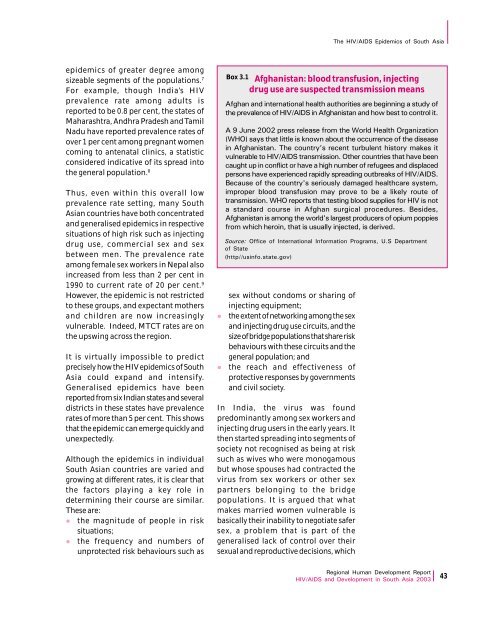Download Report - UNDP Asia-Pacific Regional Centre - United ...
Download Report - UNDP Asia-Pacific Regional Centre - United ...
Download Report - UNDP Asia-Pacific Regional Centre - United ...
Create successful ePaper yourself
Turn your PDF publications into a flip-book with our unique Google optimized e-Paper software.
The HIV/AIDS Epidemics of South <strong>Asia</strong>epidemics of greater degree amongsizeable segments of the populations. 7For example, though India’s HIVprevalence rate among adults isreported to be 0.8 per cent, the states ofMaharashtra, Andhra Pradesh and TamilNadu have reported prevalence rates ofover 1 per cent among pregnant womencoming to antenatal clinics, a statisticconsidered indicative of its spread intothe general population. 8Thus, even within this overall lowprevalence rate setting, many South<strong>Asia</strong>n countries have both concentratedand generalised epidemics in respectivesituations of high risk such as injectingdrug use, commercial sex and sexbetween men. The prevalence rateamong female sex workers in Nepal alsoincreased from less than 2 per cent in1990 to current rate of 20 per cent. 9However, the epidemic is not restrictedto these groups, and expectant mothersand children are now increasinglyvulnerable. Indeed, MTCT rates are onthe upswing across the region.It is virtually impossible to predictprecisely how the HIV epidemics of South<strong>Asia</strong> could expand and intensify.Generalised epidemics have beenreported from six Indian states and severaldistricts in these states have prevalencerates of more than 5 per cent. This showsthat the epidemic can emerge quickly andunexpectedly.Although the epidemics in individualSouth <strong>Asia</strong>n countries are varied andgrowing at different rates, it is clear thatthe factors playing a key role indetermining their course are similar.These are:l the magnitude of people in risksituations;l the frequency and numbers ofunprotected risk behaviours such asllBox 3.1 Afghanistan: blood transfusion, injectingdrug use are suspected transmission meansAfghan and international health authorities are beginning a study ofthe prevalence of HIV/AIDS in Afghanistan and how best to control it.A 9 June 2002 press release from the World Health Organization(WHO) says that little is known about the occurrence of the diseasein Afghanistan. The country’s recent turbulent history makes itvulnerable to HIV/AIDS transmission. Other countries that have beencaught up in conflict or have a high number of refugees and displacedpersons have experienced rapidly spreading outbreaks of HIV/AIDS.Because of the country's seriously damaged healthcare system,improper blood transfusion may prove to be a likely route oftransmission. WHO reports that testing blood supplies for HIV is nota standard course in Afghan surgical procedures. Besides,Afghanistan is among the world's largest producers of opium poppiesfrom which heroin, that is usually injected, is derived.Source: Office of International Information Programs, U.S Departmentof State(http//usinfo.state.gov)sex without condoms or sharing ofinjecting equipment;the extent of networking among the sexand injecting drug use circuits, and thesize of bridge populations that share riskbehaviours with these circuits and thegeneral population; andthe reach and effectiveness ofprotective responses by governmentsand civil society.In India, the virus was foundpredominantly among sex workers andinjecting drug users in the early years. Itthen started spreading into segments ofsociety not recognised as being at risksuch as wives who were monogamousbut whose spouses had contracted thevirus from sex workers or other sexpartners belonging to the bridgepopulations. It is argued that whatmakes married women vulnerable isbasically their inability to negotiate safersex, a problem that is part of thegeneralised lack of control over theirsexual and reproductive decisions, which<strong>Regional</strong> Human Development <strong>Report</strong>HIV/AIDS and Development in South <strong>Asia</strong> 2003 43
















